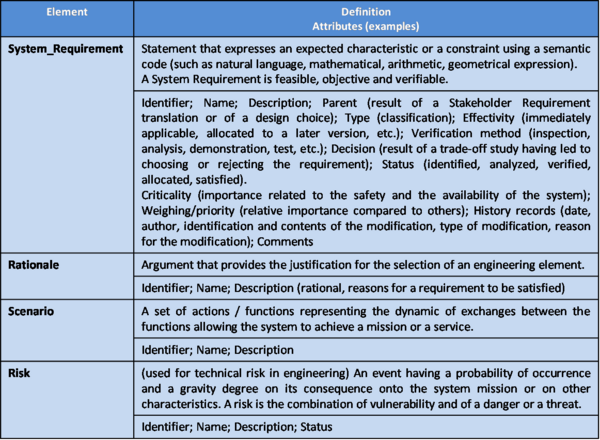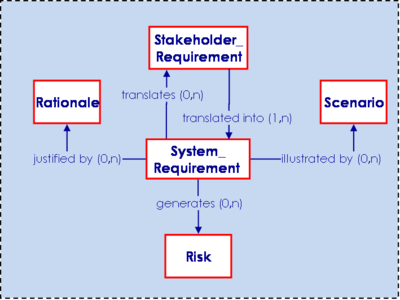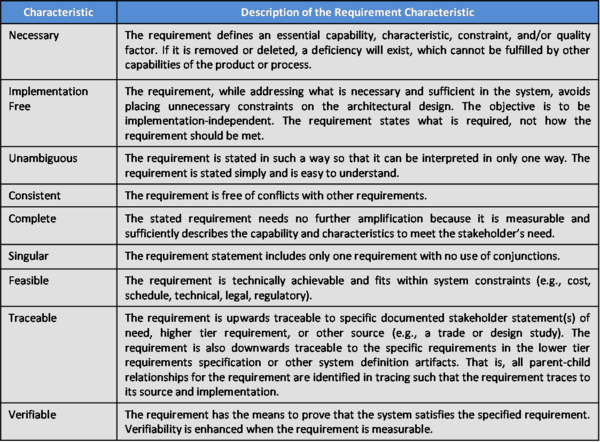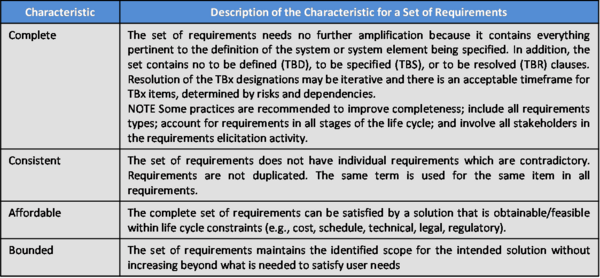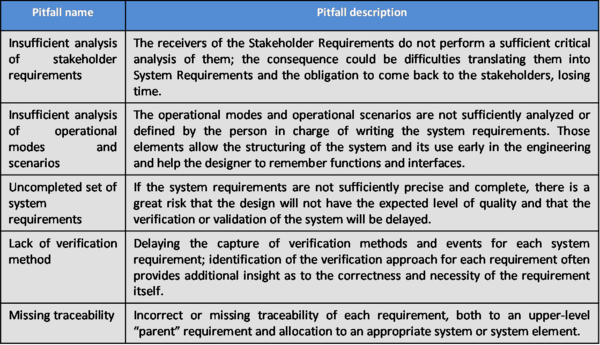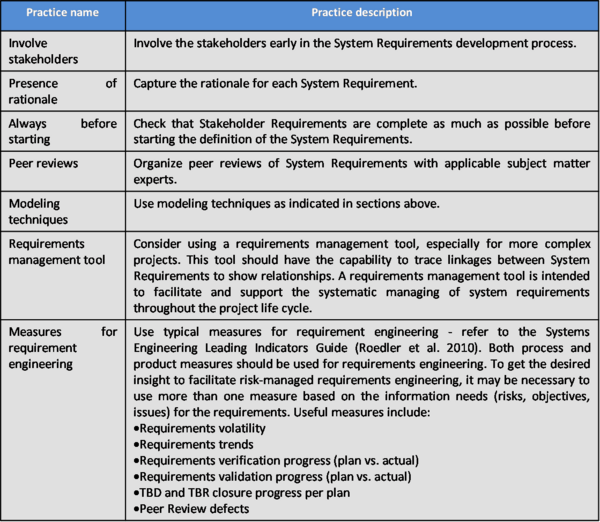Difference between revisions of "Stakeholder Requirements Definition"
(No difference)
|
Revision as of 20:53, 9 August 2011
Introduction, Definition and Purpose of System Requirements
Introduction - This section provides knowledge about the notion of system requirements, the translation of Stakeholder Requirements into System Requirements, the relationships between the system requirements of the System of Interest and those of its systems or system elements, and the related SE activities and methods. The set of baselined System Requirements is one of the major outcomes of these activities. This set represents the problem from a supplier and a designer point of view, and it can be viewed also as a model of the expected System of Interest.
Definition and Purpose - A requirement is “a statement that identifies a system, product or process characteristic or constraint, which is unambiguous, clear, unique, consistent, stand‐alone (not grouped), and verifiable, and is deemed necessary for stakeholder acceptability.” (INCOSE. 2010) p. 362. The System Requirements are all of the requirements at the “system level” that have been properly translated from the list of stakeholders' requirements. The System Requirements will form the basis of system design, verification, and stakeholder acceptance. In this context, the “stakeholders” include, but are not limited to, end users, end user organizations, supporters, developers, producers, trainers, maintainers, disposers, acquirers, customers, operators, supplier organizations, accreditors, and regulatory bodies. (ISO/IEC. 2011)
System Requirements play major intricate roles in the engineering activities. They serve:
- as the essential inputs of the system design activities, in order designers know what characteristics are expected and so being able to give corresponding properties to the solution.
- as reference for the system validation activities, in order testers may review the requirements during their development checking their right expression as validation reference, and identifying the necessary means to test the system against the requirements.
- as a communication means, between the various technical staff that interact within the project.
Principles about System Requirements
Translation of Stakeholder Requirements into System Requirements
Quite often, the set of Stakeholder Requirements may contain vague, ambiguous, and qualitative “user-oriented” requirements that are difficult to use for design or to verify. Each of these requirements may need to be further clarified and translated into “engineering-oriented” language to enable proper design and verification activities. The System Requirements resulting from this translation are expressed in technical language useful for design; unambiguous, consistent, with no contradiction, exhaustive, and verifiable. Of course, close coordination with the stakeholders is necessary to ensure the translation is accurate.
As an example, a need or an expectation such as "To manoeuvre easily a car to park it", will be transformed in a set of Stakeholder Requirements such as, "Increase the drivability of the car", "Decrease the effort for handling", "Assist the piloting", "Protect the coachwork against shocks or scratch", etc. Analyzing for example the Stakeholder Requirement "Increase the drivability of the car", it will be translated in a set of System Requirements specifying measurable characteristics such as the turning circle (steering lock), the wheelbase, etc.
Traceability and assignment of System Requirements during design
Requirements traceability provides the ability to trace information from the origin of the Stakeholder Requirements at the top level to the lowest level of the system hierarchy - see section "Top-down and recursive approach to system decomposition" in the topic Fundamentals of System Definition. Traceability is also used to provide an understanding of the extent of a change as an input to impact analyses conducted with respect to proposed engineering improvements or requests for change.
During design, the assignment of requirements from one level to lower levels in the system hierarchy can be accomplished using several methods, as appropriate - see Table 1.
Table 1 - Assignment types for a System Requirement NEW TABLE
Classification of System Requirements
Several classifications of System Requirements are possible, depending on the requirements definition methods and/or the design methods used. (ISO/IEC. 2011) provides a classification summarized below – see references for other interesting classifications. An example is given in Table 2.
Table 2 - Example of System Requirements classification NEW TABLE
Process Approach – System Requirements
Purpose and Principle of the Approach
The purpose of the system requirements analysis process is to transform the stakeholder, user-oriented view of desired services into a technical view of the product that meets the operational needs of the user. This process builds a representation of the system that will meet Stakeholder Requirements and that, as far as constraints permit, does not imply any specific implementation. It results in measurable System Requirements that specify, from the supplier’s perspective, what performance and non-performance characteristics it must possess in order to satisfy stakeholders' requirements. (ISO/IEC. 2008)
Activities of the process
Major activities and tasks performed during this process include:
- Analyzing the Stakeholder Requirements to check completeness of expected services and operational scenarios , conditions, Operational Modes, and constraints.
- Defining the System Requirements and its rationale .
- Classifying the System Requirements using suggested classifications classifications – see examples above.
- Incorporating the derived requirements (coming from design) into the System Requirements baseline.
- Establishing the upward traceability with the Stakeholder Requirements.
- Verifying the quality, completeness of each System Requirement and the consistency of the set of System Requirements.
- Validating the content and relevance of each System Requirement against the set of Stakeholder Requirements.
- Identifying potential risks (or threats and hazards) that could be generated by the System Requirements.
- Synthesizing, recording, and managing the System Requirements and potential associated Risks.
Artifacts and Ontology Elements
This process may create several artifacts such as:
- System Requirements Document
- System Requirements Justification Document (for traceability purpose)
- System Requirements Database, including traceability, analysis, rationale, decisions, and attributes, where appropriate.
- System External Interface Requirements Document (this document describes the interfaces of the system with external elements of its context of use; the interface requirements can be integrated or not to the System Requirements Document above).
This process handles the ontology elements of Table 3.
Table 3. Main ontology elements as handled within system requirements definition
The main relationships between ontology elements are presented in Figure 1.
Figure 1. System Requirements relationships with other engineering elements (Faisandier, 2011)
Checking and Correctness of System Requirements
System Requirements should be checked to gauge whether they are well expressed and appropriate. There are number of characteristics which can be used to check System Requirements. The set of System Requirements can be verified using standard peer review techniques and by comparing each requirement against the set of requirements characteristics listed in Table 2 and Table 3 of section "Presentation and Quality of Requirements".
The requirements can be validated using the requirements elicitation and rationale capture described in section "Methods and Modeling Techniques" further.
Methods and Modeling Techniques
Requirements Elicitation and Prototyping
Requirements Elicitation is one approach that requires user involvement, and can be effective in gaining stakeholder involvement and buy-in. QFD (Quality Function Deployment) and prototyping are two common techniques that can be applied and are defined in this section. In addition, interviews, focus groups, and Delphi techniques are often applied to elicit requirements.
QFD is a powerful technique to elicit requirements and compare design characteristics against user needs. The inputs to the QFD application are user needs and operational concepts, so it is essential that the users participate. Users from across the life cycle should be included so that all aspects of user needs are accounted for and prioritized.
Early prototyping can help the users and developers identify the functional and operational requirements and user interface constraints through interactive use of system elements, models, and simulations. The prototyping allows for realistic user interaction, discovery, and feedback, as well as some sensitivity analysis. This helps to form a more complete set of requirements by improving the user’s requirements understanding.
Capturing Requirements Rationale
One powerful and cost-effective technique to translate Stakeholder Requirements to System Requirements is to capture the rationale for each requirement. Requirements rationale is merely a statement as to why the requirement exists, any assumptions made, the results of related design studies, or any other related supporting information. This is especially powerful in capturing the rationale for stakeholder requirements, as this supports further requirements analysis and decomposition. The rationale can be captured directly in the requirements database. Of course, stakeholder involvement is essential for this process. It is possible to extend the method providing rationale that explains why a set of requirements satisfies a higher-level one – see (Hull, M. E. C., Jackson, K., Dick, A. J. J. 2010) Chapter 7.
Some of the benefits include:
- Reducing the total number of requirements. As requirements are gathered and rationale is required for each, the requirement author may realize that a particular requirement may not be required or supportable, or that it duplicates an existing requirement. Reducing requirements count will reduce project cost and risk.
- Early exposure of bad assumptions. Many poorly written or incorrect requirements are based upon faulty assumptions. By capturing (and questioning) requirements rationale, incorrect or faulty assumptions can be exposed early in the process, and the related requirements can be eliminated or properly rewritten.
- Removes design implementation. Many poorly written stakeholder requirements are design requirements in disguise, in that the customer is intentionally or unintentionally specifying a candidate implementation. The requirements authors may be jumping to solution space, rather that stating the problem to be solved. By properly capturing requirements rationale, these “design requirements” are often exposed and rewritten properly to allow appropriate design latitude to develop a cost-effective solution.
- Improves communication with the stakeholder community. By capturing the requirements rationale for all Stakeholders Requirements, the line of communication between the users and the designers is greatly improved. This will result in better understanding of the problem space, elimination of ambiguous requirements, and, eventually, a greatly improved system validation process, etc. since the intent of the stakeholders is well-documented and clarified. Adapted from (Hooks, I. F., and K. A. Farry. 2000) Chapter 8.
Modeling Techniques
Modeling techniques can be used when requirements must be detailed or refined, or when they address topics not considered during the Stakeholder Requirements Definition and Mission Analysis:
- State-charts models (ISO/IEC. 2011) Section 8.4.2
- Scenarios modeling (ISO/IEC. 2011) Section 6.2.3.1
- Simulations, prototyping (ISO/IEC. 2011) Section 6.3.3.2
- Quality Function Deployment (INCOSE. 2010) p. 83
- Sequence diagram, Activity diagram, Use case, State machine diagram, Requirements diagram of SysML
- Functional Flow Block Diagram for Operational Scenario
- Etc.
Presentation and Quality of Requirements
Generally, requirements are provided in a textual form. Guidelines exist to write good requirements; they include recommendations about sentence syntax, wording (exclusions, representation of concepts, etc.), semantics (specific, measurable, achievable, realistic, testable). Refer to (INCOSE. 2010) section 4.2.2.2.
There are several characteristics of requirements and sets of requirements that ensure the quality of requirements. These are used both to aid the development of the requirements and to verify the implementation of requirements into the solution. Table 4 provides a list and descriptions of the characteristics for individual requirements and Table 5 provides a list and descriptions of characteristics for a set of requirements, as adapted from (ISO/IEC. 2011) sections 5.2.5 and 5.2.6.
Table 4. Characteristics of Individual Requirements (ISO/IEC 29148)
Table 5. Characteristics of a Set of Requirements (ISO/IEC 29148)
Requirements in Tables
Requirements may be provided in a table, especially when specifying a set of parameters for the system or a system element. It is good practice to make standard table templates available. For tables, the following conventions apply:
- Invoke each requirements table in the requirements set that clearly points to the table.
- Identify each table with a unique title and table number.
- Include the word “requirements” in the table title.
- Identify the purpose of the table in the text immediately preceding it and include an explanation of how to read and use the table, including context and units.
- For independent-dependant variable situations, organize the table in a way that best accommodates the use of the information.
- Each cell should contain, at most, a single requirement.
Requirements in Flow Charts
Flow charts often contain requirements in a graphical form. These requirements may include logic that must be incorporated into the system, operational requirements, process or procedural requirements, or other situations that are best defined graphically by a sequence of interrelated steps. For flow charts, the following conventions apply:
- Invoke flow charts in the requirements set that clearly points to the flow chart.
- Identify each flow chart with a unique title and figure number.
- Include the word “requirements” in the title of the flow chart
- Clearly indicate and explain unique symbols that represent requirements in the flow chart.
Requirements in Drawings
Drawings also provide a graphical means to define requirements. The type of requirement defined in a drawing depends on the type of drawing. Following conventions apply:
- Drawings are used when they can aid in the description of the following:
- Spatial requirements
- Interface requirements
- Layout requirements
- Invoke drawings in the requirements set that clearly points to the drawing.
Application to Product systems, Service systems, Enterprise systems
The classification of System Requirements may have differences between those types of systems.
Practical Considerations about System Requirements
There are several pitfalls that will inhibit the generation and management of an optimal set of System Requirements. See Table 6.
Table 6. Major pitfalls with definition of System Requirements
The following proven practices in system requirements engineering have repeatedly been shown to reduce project risk and cost, foster customer satisfaction, and produce successful system development. See Table 7.
Table 7. Proven practices with definition of System Requirements
References
Please make sure all references are listed alphabetically and are formatted according to the Chicago Manual of Style (15th ed). See the BKCASE Reference Guidance for additional information.
Citations
List all references cited in the article. Note: SEBoK 0.5 uses Chicago Manual of Style (15th ed). See the BKCASE Reference Guidance for additional information.
INCOSE. 2010. INCOSE systems engineering handbook, version 3.2. San Diego, CA, USA: International Council on Systems Engineering (INCOSE), INCOSE-TP-2003-002-03.2.
ISO/IEC. 2011. Systems and software engineering - Life cycle processes - Requirements engineering. Geneva, Switzerland: International Organization for Standardization (ISO)/International Electronical Commission (IEC), ISO/IEC FDIS 29148.
ISO/IEC. 2008. Systems and software engineering - system life cycle processes. Geneva, Switzerland: International Organization for Standardization (ISO)/International Electronical Commission (IEC), ISO/IEC 15288:2008 (E).
Hull, M. E. C., Jackson, K., Dick, A. J. J. 2010. Systems Engineering, 3rd ed. London: Springer.
Hooks, I. F., and K. A. Farry. 2000. Customer-centered products: Creating successful products through smart requirements management. New York, NY: American Management Association.
Primary References
All primary references should be listed in alphabetical order. Remember to identify primary references by creating an internal link using the ‘’’reference title only’’’ (title). Please do not include version numbers in the links.
INCOSE. 2010. INCOSE systems engineering handbook, version 3.2. San Diego, CA, USA: International Council on Systems Engineering (INCOSE), INCOSE-TP-2003-002-03.2.
ISO/IEC. 2008. Systems and software engineering - system life cycle processes. Geneva, Switzerland: International Organization for Standardization (ISO)/International Electronical Commission (IEC), ISO/IEC 15288:2008 (E).
ISO/IEC. 2011. Systems and software engineering - Life cycle processes - Requirements engineering. Geneva, Switzerland: International Organization for Standardization (ISO)/International Electronical Commission (IEC), ISO/IEC FDIS 29148.
van Lamsweerde, A. 2009. Requirements engineering. New York, NY: Wiley.
Additional References
All additional references should be listed in alphabetical order.
Faisandier, A. 2011. Engineering and architecting multidisciplinary systems. (expected--not yet published).
Hooks, I. F., and K. A. Farry. 2000. Customer-centered products: Creating successful products through smart requirements management. New York, NY: American Management Association.
Hull, M. E. C., Jackson, K., Dick, A. J. J. 2010. Systems Engineering, 3rd ed. London: Springer.
Roedler, G., D. Rhodes, C. Jones, and H. Schimmoller. 2010. Systems engineering leading indicators guide, version 2.0. San Diego, CA: International Council on Systems Engineering (INCOSE), INCOSE-TP-2005-001-03.
